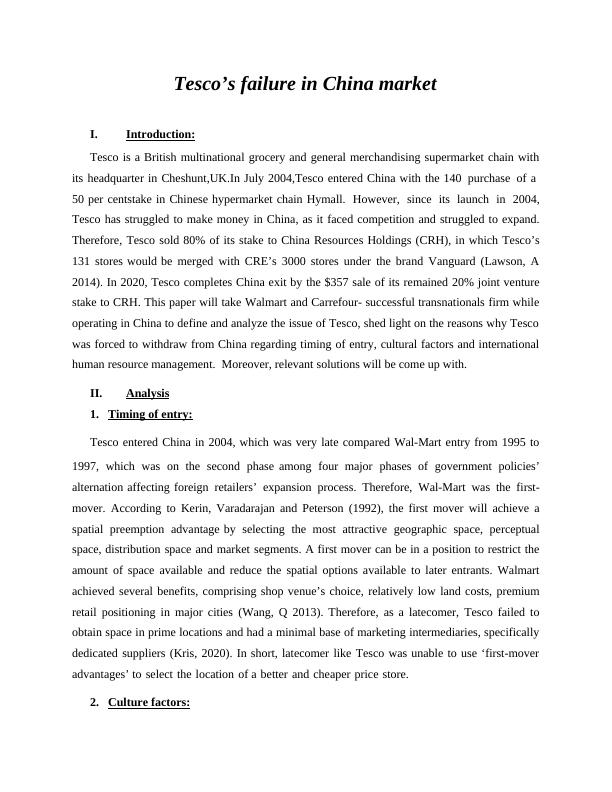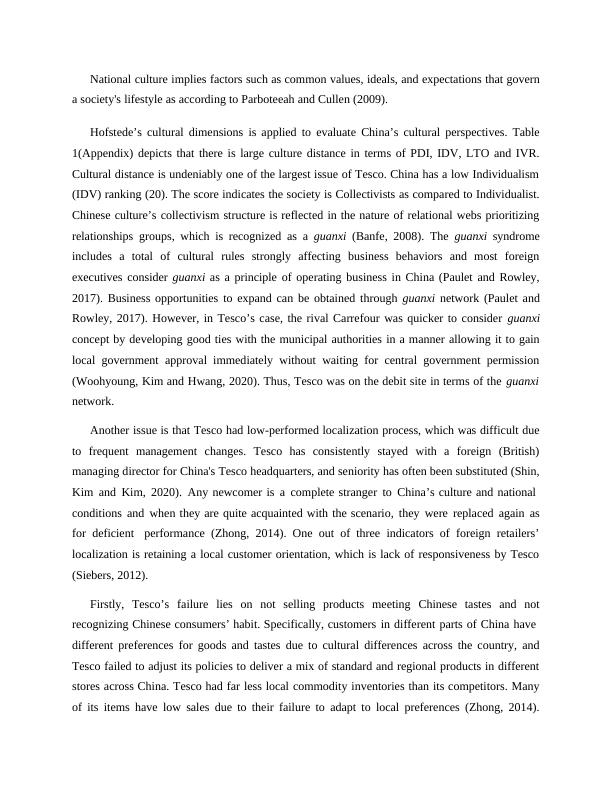BUSM 3311 – International Business Assignment
Added on 2021-11-23
8 Pages2408 Words114 Views
RMIT International University Vietnam
BUSM 3311 – International Business
A2
Subject Code: BUSM-3311 / 4626
Subject Name: International Business
Location & Campus RMIT Vietnam , Hanoi
Class Group Number: 1
Student Name: Ha Quynh Trang
Student Number: S3821868
Your Teacher: Quyen Dang Thao
Word Count:
1318
BUSM 3311 – International Business
A2
Subject Code: BUSM-3311 / 4626
Subject Name: International Business
Location & Campus RMIT Vietnam , Hanoi
Class Group Number: 1
Student Name: Ha Quynh Trang
Student Number: S3821868
Your Teacher: Quyen Dang Thao
Word Count:
1318

Tesco’s failure in China market
I. Introduction:
Tesco-is-a-British-multinational-grocery-and-general-merchandising-supermarket-chain-with
its-headquarter-in-Cheshunt,UK.In-July-2004,Tesco-entered-China-with-the-140 purchase of-a-
50-per-centstake-in-Chinese-hypermarket-chain-Hymall. However, since its launch in 2004,
Tesco has struggled to make money in China, as it faced competition and struggled to expand.
Therefore, Tesco sold 80% of its stake to China Resources Holdings (CRH), in which Tesco’s
131 stores-would-be merged with CRE’s 3000 stores under the brand Vanguard (Lawson, A
2014). In 2020, Tesco completes China exit by the $357 sale of its remained 20% joint venture
stake to CRH. This paper will take Walmart and Carrefour- successful transnationals firm while
operating in China to define and analyze the issue of Tesco, shed light on the reasons why Tesco
was forced to withdraw from China regarding timing of entry, cultural factors and international
human resource management. Moreover, relevant solutions will be come up with.
II. Analysis
1. Timing of entry:
Tesco entered China in 2004, which was very late compared Wal-Mart entry from 1995 to
1997, which was on the second phase-among four major phases of government policies’
alternation-affecting-foreign retailers’ expansion process. Therefore, Wal-Mart was the first-
mover. According to Kerin, Varadarajan and Peterson (1992), the first mover will achieve a
spatial preemption advantage-by selecting the most attractive geographic space, perceptual
space, distribution-space-and-market-segments. A first mover can be in a position to restrict the
amount of space available and reduce the spatial options available to later entrants. Walmart
achieved several benefits, comprising shop venue’s choice, relatively low land costs, premium
retail positioning in major cities (Wang, Q 2013). Therefore, as a latecomer, Tesco failed to
obtain space in prime locations and had a minimal base of marketing intermediaries, specifically
dedicated suppliers (Kris, 2020). In short, latecomer like Tesco was unable to use ‘first-mover
advantages’ to-select-the-location-of a-better-and-cheaper-price-store.
2. Culture factors:
I. Introduction:
Tesco-is-a-British-multinational-grocery-and-general-merchandising-supermarket-chain-with
its-headquarter-in-Cheshunt,UK.In-July-2004,Tesco-entered-China-with-the-140 purchase of-a-
50-per-centstake-in-Chinese-hypermarket-chain-Hymall. However, since its launch in 2004,
Tesco has struggled to make money in China, as it faced competition and struggled to expand.
Therefore, Tesco sold 80% of its stake to China Resources Holdings (CRH), in which Tesco’s
131 stores-would-be merged with CRE’s 3000 stores under the brand Vanguard (Lawson, A
2014). In 2020, Tesco completes China exit by the $357 sale of its remained 20% joint venture
stake to CRH. This paper will take Walmart and Carrefour- successful transnationals firm while
operating in China to define and analyze the issue of Tesco, shed light on the reasons why Tesco
was forced to withdraw from China regarding timing of entry, cultural factors and international
human resource management. Moreover, relevant solutions will be come up with.
II. Analysis
1. Timing of entry:
Tesco entered China in 2004, which was very late compared Wal-Mart entry from 1995 to
1997, which was on the second phase-among four major phases of government policies’
alternation-affecting-foreign retailers’ expansion process. Therefore, Wal-Mart was the first-
mover. According to Kerin, Varadarajan and Peterson (1992), the first mover will achieve a
spatial preemption advantage-by selecting the most attractive geographic space, perceptual
space, distribution-space-and-market-segments. A first mover can be in a position to restrict the
amount of space available and reduce the spatial options available to later entrants. Walmart
achieved several benefits, comprising shop venue’s choice, relatively low land costs, premium
retail positioning in major cities (Wang, Q 2013). Therefore, as a latecomer, Tesco failed to
obtain space in prime locations and had a minimal base of marketing intermediaries, specifically
dedicated suppliers (Kris, 2020). In short, latecomer like Tesco was unable to use ‘first-mover
advantages’ to-select-the-location-of a-better-and-cheaper-price-store.
2. Culture factors:

National culture implies factors such as common values, ideals, and expectations that govern
a society's lifestyle as according to Parboteeah and Cullen (2009).
Hofstede’s cultural dimensions is applied to evaluate China’s cultural perspectives. Table
1(Appendix) depicts that there is large culture distance in terms of PDI, IDV, LTO and IVR.
Cultural distance is undeniably one of the largest issue of Tesco. China has a low Individualism
(IDV) ranking (20). The score indicates the society is Collectivists as compared to Individualist.
Chinese culture’s collectivism structure is reflected in the nature of relational webs prioritizing
relationships groups, which is recognized as a guanxi (Banfe, 2008). The guanxi syndrome
includes a total of cultural rules strongly affecting business behaviors and most foreign
executives consider guanxi as a principle of operating business in China (Paulet and Rowley,
2017). Business opportunities to expand can be obtained through guanxi network (Paulet and
Rowley, 2017). However, in Tesco’s case, the rival Carrefour was quicker to consider guanxi
concept by developing good ties with the municipal authorities in a manner allowing it to gain
local government approval immediately without waiting for central government permission
(Woohyoung, Kim and Hwang, 2020). Thus, Tesco was on the debit site in terms of the guanxi
network.
Another issue is that Tesco had low-performed localization process, which was difficult due
to frequent management changes. Tesco has consistently stayed with a foreign (British)
managing director for China's Tesco headquarters, and seniority has often been substituted (Shin,
Kim and Kim, 2020). Any-newcomer-is a complete-stranger to China’s-culture-and-national-
conditions and when-they-are-quite-acquainted-with-the-scenario, they were replaced again as
for deficient- performance (Zhong, 2014). One out of three indicators of foreign retailers’
localization is retaining a local customer orientation, which is lack of responsiveness by Tesco
(Siebers, 2012).
Firstly, Tesco’s failure lies on not selling products meeting Chinese tastes and not
recognizing Chinese consumers’ habit. Specifically, customers-in-different-parts-of-China-have-
different preferences for goods and tastes due to cultural differences across the country, and
Tesco failed to adjust its policies to deliver a mix of standard and regional products in different
stores across China. Tesco had far less local commodity inventories than its competitors. Many
of its items have low sales due to their failure to adapt to local preferences (Zhong, 2014).
a society's lifestyle as according to Parboteeah and Cullen (2009).
Hofstede’s cultural dimensions is applied to evaluate China’s cultural perspectives. Table
1(Appendix) depicts that there is large culture distance in terms of PDI, IDV, LTO and IVR.
Cultural distance is undeniably one of the largest issue of Tesco. China has a low Individualism
(IDV) ranking (20). The score indicates the society is Collectivists as compared to Individualist.
Chinese culture’s collectivism structure is reflected in the nature of relational webs prioritizing
relationships groups, which is recognized as a guanxi (Banfe, 2008). The guanxi syndrome
includes a total of cultural rules strongly affecting business behaviors and most foreign
executives consider guanxi as a principle of operating business in China (Paulet and Rowley,
2017). Business opportunities to expand can be obtained through guanxi network (Paulet and
Rowley, 2017). However, in Tesco’s case, the rival Carrefour was quicker to consider guanxi
concept by developing good ties with the municipal authorities in a manner allowing it to gain
local government approval immediately without waiting for central government permission
(Woohyoung, Kim and Hwang, 2020). Thus, Tesco was on the debit site in terms of the guanxi
network.
Another issue is that Tesco had low-performed localization process, which was difficult due
to frequent management changes. Tesco has consistently stayed with a foreign (British)
managing director for China's Tesco headquarters, and seniority has often been substituted (Shin,
Kim and Kim, 2020). Any-newcomer-is a complete-stranger to China’s-culture-and-national-
conditions and when-they-are-quite-acquainted-with-the-scenario, they were replaced again as
for deficient- performance (Zhong, 2014). One out of three indicators of foreign retailers’
localization is retaining a local customer orientation, which is lack of responsiveness by Tesco
(Siebers, 2012).
Firstly, Tesco’s failure lies on not selling products meeting Chinese tastes and not
recognizing Chinese consumers’ habit. Specifically, customers-in-different-parts-of-China-have-
different preferences for goods and tastes due to cultural differences across the country, and
Tesco failed to adjust its policies to deliver a mix of standard and regional products in different
stores across China. Tesco had far less local commodity inventories than its competitors. Many
of its items have low sales due to their failure to adapt to local preferences (Zhong, 2014).

End of preview
Want to access all the pages? Upload your documents or become a member.